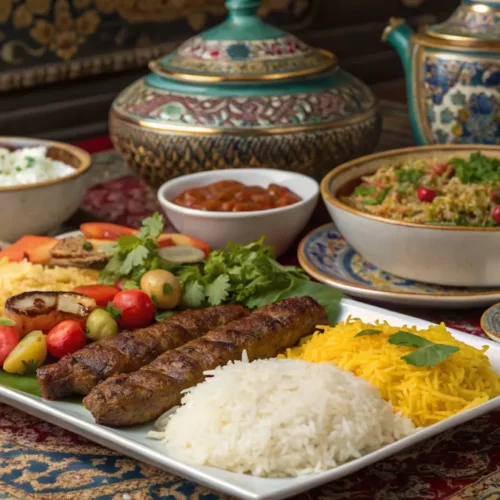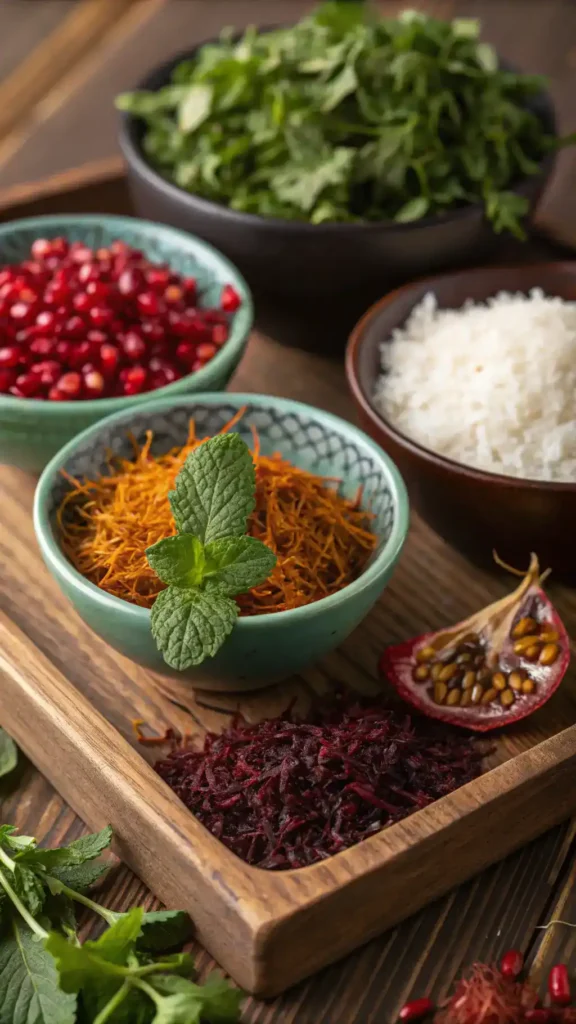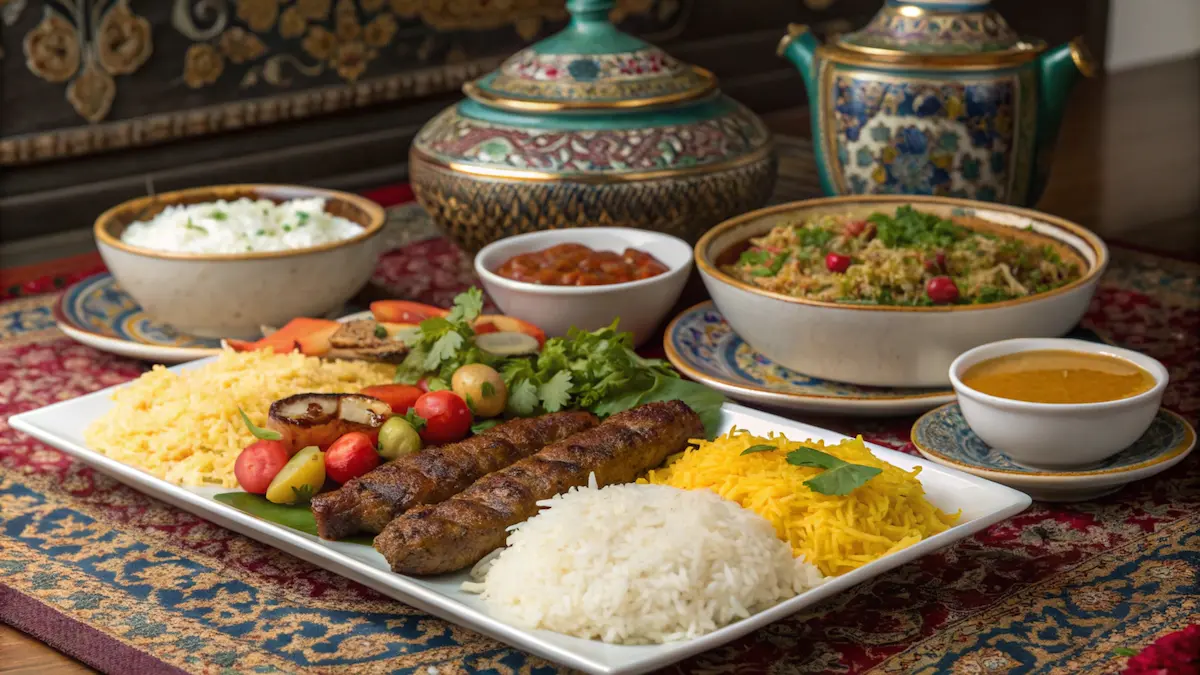Imagine stepping into a vibrant Persian bazaar, where the air is filled with the intoxicating aromas of fresh herbs and spices. This culinary adventure invites you to explore the rich tapestry of Persian recipes, each dish telling a story of tradition and culture. Not only do these recipes offer a delightful flavor journey, but they also come with numerous health benefits, making them perfect for health-conscious cooking. By mastering these dishes, you will enhance your culinary skills while connecting with family traditions that have been cherished for generations.
To create authentic Persian meals, you will need essential ingredients such as saffron, sumac, and basmati rice. These aromatic ingredients, along with fresh herbs and vegetables, are key to achieving the unique flavor profiles that define Persian cuisine. If you find certain ingredients hard to source, don’t worry—there are plenty of substitutions that can help you recreate these beloved dishes in your own kitchen.
In this guide, you will find a step-by-step approach to making popular Persian recipes, including kebabs and stews. You will learn traditional cooking techniques that infuse flavors beautifully, ensuring that every bite is a taste of Persia. Furthermore, I will share expert tips to troubleshoot common cooking challenges, allowing you to customize recipes to suit your preferences.
As you prepare to serve your creations, consider pairing them with fresh salads or yogurt sauces, enhancing both presentation and flavor. The cultural significance of how you present your meals adds another layer of enjoyment to your dining experience. Lastly, I will provide storage tips to ensure your leftovers remain fresh and delicious, making meal prep a breeze.
So, gather your ingredients and get ready to embark on this flavorful journey. Cooking Persian recipes at home not only satisfies your taste buds but also opens the door to a deeper appreciation of a rich culinary heritage.
Table of Contents
Table of Contents

persian recipes
Ingredients
Essential Ingredients
- 1 gram Saffron Use sparingly for flavor and color.
- 1 tablespoon Sumac For sprinkling on dishes.
Fresh Herbs
- 1 bunch Parsley Chopped, for garnish.
- 1 bunch Cilantro Chopped, for garnish.
Grains
- 2 cups Basmati Rice Rinse thoroughly before cooking.
Legumes
- 1 cup Chickpeas Cooked or canned.
Vegetables
- 1 medium Onion Finely chopped.
- 2 medium Tomatoes Chopped.
- 1 medium Eggplant Chopped.
Fruits
- 1/2 cup Pomegranate Seeds For garnish.
Instructions
Gather Your Ingredients
- Start by assembling the essential ingredients. Ensure everything is fresh, as this significantly impacts the flavor.
Prepare Your Base
- Begin by marinating your proteins. Mix yogurt, garlic, and spices to create a marinade for chicken or lamb. Allow it to marinate for at least an hour, preferably overnight.
Cook Your Rice
- Rinse your basmati rice under cold water until the water runs clear. Soak the rice in water for about 30 minutes before cooking. Boil it in salted water until it’s al dente, and drain it.
Build Layers of Flavor
- In a pot, heat some oil and sauté finely chopped onions until golden. Add your marinated meat or vegetables, cooking them until browned.
Add Aromatics
- Once your meat is browned, add garlic, spices, and any vegetables you’re using. Stir them in and let them cook for a few minutes.
Simmer to Perfection
- Add water or broth to your pot, ensuring the ingredients are submerged. Bring it to a boil, then reduce the heat and let it simmer.
Finish with Fresh Herbs
- Near the end of cooking, stir in freshly chopped herbs.
Serve with Love
- Once your dish is ready, serve it hot with a side of yogurt sauce or a fresh salad.
Notes
| Calories | Fat | Protein | Carbs |
|---|---|---|---|
| 350 | 10g | 15g | 50g |
Key Benefits of Persian Recipes
Are you ready to dive into the vibrant world of Persian recipes? Not only do these dishes offer a delightful culinary experience, but they also come with a host of benefits that can enhance your well-being and cooking skills. Let’s explore why you should embrace these flavorful creations!
Cultural Experience
Firstly, cooking Persian recipes allows you to connect with a rich cultural heritage. Each dish tells a story, reflecting centuries of tradition and family gatherings. By preparing these meals, you’re not just cooking; you’re participating in a cultural experience that brings people together.
Health Benefits
Moreover, Persian recipes often feature fresh herbs, spices, and wholesome ingredients. For example, dishes commonly include ingredients like saffron, sumac, and a variety of vegetables. These components are not only flavorful but also packed with nutrients. Consequently, you can enjoy meals that are both delicious and health-conscious.
Flavor Profiles
Additionally, the flavor profiles in Persian cuisine are truly unique. The combination of spices creates a symphony of tastes that can elevate any meal. Whether it’s the aromatic basmati rice or the succulent kebabs, each bite is an explosion of flavor that will leave you craving more!
Enhancing Culinary Skills
Furthermore, mastering Persian recipes can significantly enhance your culinary skills. As you learn traditional cooking techniques, you’ll gain confidence in the kitchen. This experience not only boosts your cooking repertoire but also encourages creativity in meal preparation.
Joy of Homemade Meals
Finally, there’s something incredibly satisfying about creating homemade meals. Persian recipes invite you to experiment with ingredients and flavors, making cooking a joyful adventure. So, gather your loved ones and enjoy the process of cooking together, creating memories that will last a lifetime.
In summary, embracing Persian recipes is not just about the food; it’s about the experience, health benefits, and joy of cooking. So, why not start your culinary journey today? You’ll be amazed at the flavors and traditions you’ll discover along the way!
Essential Ingredients for Persian Recipes
Embarking on a culinary journey through Persian recipes is not only about the cooking techniques but also about the vibrant ingredients that bring these dishes to life. Below, you’ll find a carefully curated list of essential ingredients that are staples in Persian cuisine. Each ingredient contributes to the unique flavor profiles and health benefits that make these recipes so delightful.
- Saffron: This precious spice is a hallmark of Persian cooking. It adds a golden hue and a distinct aroma to dishes. Use it sparingly, as a little goes a long way.
- Sumac: With its tangy flavor, sumac is often sprinkled on kebabs and salads. It brightens up dishes and is a fantastic alternative to lemon.
- Fresh Herbs: Herbs like parsley, cilantro, and mint are essential. They not only enhance flavor but also provide health benefits. Always opt for fresh herbs when possible.
- Basmati Rice: The foundation of many Persian meals, basmati rice is known for its fragrant aroma and fluffy texture. Rinse it thoroughly before cooking to achieve the perfect grain.
- Legumes: Chickpeas and lentils are commonly used in stews and salads. They add protein and fiber, making your meals hearty and nutritious.
- Vegetables: Onions, tomatoes, and eggplants are frequently featured in Persian dishes. They provide depth and richness, especially in stews.
- Pomegranate: Often used in salads and as a garnish, pomegranate seeds add a burst of sweetness and color. They are also packed with antioxidants.

When preparing Persian recipes, using high-quality, fresh ingredients is crucial. If you can’t find something, don’t worry! For instance, if saffron is unavailable, consider using turmeric for color, albeit the flavor will differ. Additionally, sumac can be substituted with a mix of lemon zest and a pinch of salt if needed. By understanding these ingredients, you’ll not only enhance your culinary skills but also deepen your appreciation for the rich cultural experience that Persian cuisine offers.
How to Make Persian Recipes
Embarking on the journey of creating authentic Persian recipes is not only a culinary adventure but also a delightful cultural experience. Below, I’ll guide you through a step-by-step process that will enhance your culinary skills and allow you to savor the unique flavor profiles of Persian cuisine.
- Gather Your Ingredients: Start by assembling the essential ingredients. For most Persian recipes, you’ll need fresh herbs like parsley and cilantro, aromatic spices such as saffron and sumac, grains like basmati rice, and legumes like chickpeas. Ensure everything is fresh, as this significantly impacts the flavor.
- Prepare Your Base: If you’re making a stew or a kebab, begin by marinating your proteins. For example, mix yogurt, garlic, and spices to create a marinade for chicken or lamb. Allow it to marinate for at least an hour, preferably overnight, to infuse the flavors.
- Cook Your Rice: For a perfect Persian rice dish, rinse your basmati rice under cold water until the water runs clear. This step removes excess starch, ensuring fluffy rice. Soak the rice in water for about 30 minutes before cooking. Then, boil it in salted water until it’s al dente, and drain it.
- Build Layers of Flavor: In a pot, heat some oil and sauté finely chopped onions until golden. Add your marinated meat or vegetables, cooking them until browned. This step is crucial, as it builds a rich flavor base for your dish.
- Add Aromatics: Once your meat is browned, add garlic, spices, and any vegetables you’re using. Stir them in and let them cook for a few minutes. This allows the spices to bloom, enhancing the overall flavor of your Persian recipe.
- Simmer to Perfection: Add water or broth to your pot, ensuring the ingredients are submerged. Bring it to a boil, then reduce the heat and let it simmer. Depending on the dish, this could take anywhere from 30 minutes to a few hours. The longer it simmers, the more the flavors meld together.
- Finish with Fresh Herbs: Near the end of cooking, stir in freshly chopped herbs. This step brightens the dish and adds a fresh element that is characteristic of Persian cuisine.
- Serve with Love: Once your dish is ready, serve it hot. Pair it with a side of yogurt sauce or a fresh salad to balance the flavors. Presentation is key in Persian culture, so take a moment to arrange your dish beautifully.

By following these steps, you’ll not only master the art of making Persian recipes but also create homemade meals that are rich in flavor and steeped in tradition. Enjoy the process and the delightful results!
Pro Tips, Variations, and Common Problems with Persian Recipes
Cooking Persian recipes can be a delightful journey, but it’s essential to navigate some common pitfalls along the way. Here are some pro tips and variations to enhance your culinary experience, ensuring that your dishes are both authentic and delicious.
Expert Tips for Success
– Use Fresh Ingredients: Always opt for fresh herbs and spices. Ingredients like saffron and sumac are crucial for achieving the authentic flavor profiles of Persian recipes. If you can’t find them, consider using turmeric for saffron and lemon zest for sumac.
– Balance Your Flavors: Persian cuisine is known for its harmonious balance of sweet and savory. For instance, if your dish feels too tart, add a touch of sugar or honey to round out the flavors.
– Perfect Your Rice: When making rice dishes, rinse your basmati rice thoroughly before cooking. This step removes excess starch, resulting in fluffy grains. Additionally, soaking the rice for 30 minutes can improve texture.
Creative Variations
– Vegetarian Options: If you’re looking to make a vegetarian version of a traditional kebab, try using grilled vegetables or marinated tofu. These alternatives can provide a satisfying texture and flavor.
– Spice It Up: Feel free to customize the spice levels in your dishes. If you enjoy heat, add some crushed red pepper or fresh chili to your stews and rice dishes for an extra kick.
– Herb Substitutions: If you can’t find specific herbs like tarragon or fenugreek, consider using parsley or cilantro as substitutes. They can still provide a fresh taste to your Persian recipes.
Avoiding Common Mistakes
– Overcooking the Meat: One frequent mistake is overcooking meat, which can lead to dryness. To avoid this, use a meat thermometer. For kebabs, aim for an internal temperature of 160°F (71°C).
– Neglecting Marination: Marinating your meats for several hours or overnight is crucial for flavor infusion. If you’re short on time, even a quick 30-minute marinade can make a difference.
– Ignoring Presentation: Persian cuisine places a strong emphasis on presentation. Take the time to arrange your dishes beautifully. Use colorful garnishes like pomegranate seeds or fresh herbs to elevate your meal.
By following these tips and being mindful of common mistakes, you’ll be well on your way to mastering Persian recipes. Remember, cooking is all about experimentation and finding what works best for you. Enjoy the process and savor the rich flavors of Persian cuisine!
Serving Suggestions for Persian Recipes
When it comes to serving Persian recipes, presentation and pairing are key to enhancing the dining experience. Here are some delightful suggestions to impress your guests while celebrating the rich flavors of Persian cuisine.
Perfect Pairings
To complement your Persian dishes, consider these refreshing drink options:
- Pomegranate Juice: This sweet and tangy drink not only pairs beautifully with savory dishes but also adds a vibrant color to your table.
- Mint Tea: A traditional beverage, mint tea offers a refreshing contrast to the spices in your meal, making it an excellent choice.
- Rosewater Lemonade: This fragrant drink is both refreshing and aromatic, enhancing the overall dining experience.
Additionally, side dishes can elevate your meal:
- Shirazi Salad: A fresh mix of tomatoes, cucumbers, and herbs, this salad adds a crunchy texture and balances the flavors of richer dishes.
- Yogurt Sauce: Serve a side of creamy yogurt mixed with herbs and garlic. This cooling sauce complements spicy kebabs and stews perfectly.
- Persian Rice: Fluffy basmati rice, perhaps garnished with saffron or crispy tahdig, is a staple that can be served alongside any main dish.
Artful Presentation
Presentation plays a significant role in Persian cuisine. Here are some tips to make your dishes visually appealing:
- Garnish with Fresh Herbs: A sprinkle of fresh parsley or mint not only adds color but also enhances the aroma of your dish.
- Use Colorful Plates: Serving your Persian recipes on vibrant dishes can make the meal more inviting and visually striking.
- Layer Flavors: Arrange your main dish, side salad, and rice artfully on the plate to create a feast for the eyes.
By thoughtfully pairing drinks and side dishes, as well as focusing on presentation, you can create a memorable dining experience that showcases the beauty and depth of Persian recipes. So, gather your loved ones and enjoy the cultural experience that comes with each bite!
How to Store and Reheat Persian Recipes Like a Pro
Storing and reheating Persian recipes properly is essential to maintaining their rich flavors and delightful textures. Whether you’ve made a fragrant khoresh or a savory kebab, following these guidelines will ensure your dishes remain as delicious as the day they were cooked.
Storage Tips
To keep your Persian recipes fresh, it’s important to store them correctly. First, allow your dish to cool completely before transferring it to an airtight container. This prevents condensation, which can lead to spoilage. For refrigeration, most Persian dishes can last up to 3-4 days. If you want to store them for a longer period, consider freezing. Most recipes can be frozen for up to 3 months without losing their quality. Additionally, vacuum-sealing is an excellent option for preserving flavor and texture, especially for stews and rice dishes.
When storing, always label your containers with the date. This way, you can easily track freshness. Furthermore, be mindful of food safety; always refrigerate leftovers within two hours of cooking to prevent bacterial growth. If you’re unsure about a dish’s freshness, it’s better to err on the side of caution and discard it.
Reheating Methods
Reheating Persian recipes can be done effectively using several methods, each preserving the dish’s unique flavors. For stovetop reheating, place your dish in a pan over low heat. Add a splash of water or broth to maintain moisture, stirring occasionally until heated through. This method works particularly well for stews and rice dishes.
If you prefer using an oven, preheat it to 350°F (175°C). Transfer your dish to an oven-safe container, cover it with foil to retain moisture, and heat for about 20-30 minutes. This method is ideal for kebabs and baked dishes, ensuring they remain juicy and flavorful.
For a quick option, the microwave can be used, but it requires careful attention. Place your dish in a microwave-safe container, cover it loosely, and heat in short intervals of 1-2 minutes, stirring in between. This prevents uneven heating and drying out. Lastly, if you have an air fryer, it can be a fantastic tool for reheating kebabs. Set it to a low temperature and heat for about 5-10 minutes, which will help restore the crispy exterior.
In conclusion, by following these storage and reheating tips, you can enjoy your Persian recipes at their best. Whether you’re savoring leftovers or preparing a meal for guests, these methods will help you maintain the delightful flavors and textures that make Persian cuisine so special.
Conclusion
As we wrap up this delightful journey into the world of Persian recipes, I want to extend my heartfelt thanks for joining me. This recipe not only showcases the simplicity and versatility of Persian cuisine but also invites you to explore the rich tapestry of flavors that it offers. Whether you’re a seasoned cook or a beginner, I encourage you to try making this dish yourself. You’ll find that the process is not only enjoyable but also incredibly rewarding.
Moreover, I would love to hear about your culinary adventures! Please feel free to share your results or ask any questions you may have. Cooking is a wonderful opportunity for creativity, so don’t hesitate to experiment with variations or pairings that suit your taste. Persian recipes are an excellent choice for anyone looking to get creative in the kitchen, and I hope you feel inspired to embark on this flavorful journey.
In conclusion, remember that cooking is not just about the end result; it’s about the experience and the joy it brings. So, gather your ingredients, embrace the process, and enjoy every moment in your kitchen. Happy cooking!
Frequently Asked Questions About Persian Recipes
Welcome to our FAQ section! Here, we address some common questions about Persian recipes, ensuring you have all the information you need to create delicious dishes at home.
1. What are some essential ingredients in Persian cooking?
Persian recipes often feature fresh herbs, aromatic spices, and grains. Key ingredients include saffron, sumac, basmati rice, chickpeas, and pomegranate. Additionally, using fresh herbs like parsley and cilantro enhances the flavor profile. If you can’t find certain ingredients, consider substitutes like turmeric for saffron or lemon juice for sumac.
2. How can I make my Persian dishes more authentic?
To achieve authentic flavors in your Persian recipes, focus on using high-quality spices and fresh ingredients. Moreover, traditional cooking techniques, such as slow-cooking stews or properly fluffing rice, can significantly enhance the taste. Experimenting with different herbs and spices will also help you discover unique flavor combinations.
3. What are some common mistakes to avoid when cooking Persian food?
One common mistake is not allowing enough time for flavors to develop, especially in stews. Additionally, overcooking rice can lead to a mushy texture. To avoid this, rinse the rice thoroughly before cooking and use the right water-to-rice ratio. Lastly, don’t skip the garnishes; they add both flavor and visual appeal to your dishes.
4. Can I customize Persian recipes to fit dietary restrictions?
Absolutely! Persian recipes are quite versatile. For instance, you can substitute meat with legumes for a vegetarian option or use gluten-free grains instead of traditional rice. Furthermore, feel free to adjust spices and herbs according to your taste preferences. This way, you can enjoy Persian cuisine while adhering to your dietary needs.
5. How should I store and reheat leftover Persian dishes?
To maintain freshness, store leftovers in airtight containers in the refrigerator. Most Persian dishes can be reheated on the stove or in the microwave. However, be careful not to overheat, as this can alter the texture. For rice dishes, adding a splash of water before reheating can help restore moisture.
Your Flavorful Feedback
There are no reviews yet. Be the first one to write one.

